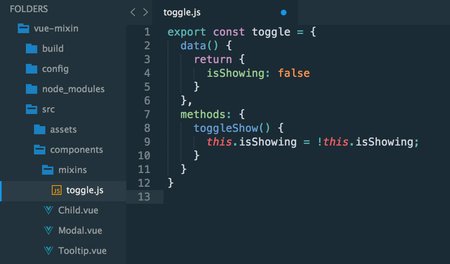Vue 之 Mixins (混入)
Mixins
Mixins是一種分發Vue組件中可複用功能的很是靈活的一種方式。

何時使用
Mixins
1. 頁面的風格不用,可是執行的方法和須要的數據相似,咱們是選擇每一個都寫呢仍是提取出公共部分呢?
基礎實例vue
咱們有一對不一樣的組件,它們的做用是切換一個狀態布爾值,一個模態框和一個提示框。這些提示框和模態框除了在功能上,沒有其餘共同點:它們看起來不同,用法不同,可是邏輯同樣。
// 模態框
const Modal = {
template: '#modal',
data() {
return {
isShowing: false
}
},
methods: {
toggleShow() {
this.isShowing = !this.isShowing;
}
},
components: {
appChild: Child
}
}
// 提示框
const Tooltip = {
template: '#tooltip',
data() {
return {
isShowing: false
}
},
methods: {
toggleShow() {
this.isShowing = !this.isShowing;
}
},
components: {
appChild: Child
}
}
解決辦法以下:
const toggle = {
data () {
isshowing: false
},
methods: {
toggleShow() {
this.isshowing = !this.isshowing
}
}
}
// 下面便可使用了
// mixins: [變量名]
const Modal = {
template: '#modal',
mixins: [toggle],
components: {
appChild: Child
}
};
const Tooltip = {
template: '#tooltip',
mixins: [toggle],
components: {
appChild: Child
}
};
若是你是以vue-cli建立的項目來寫,能夠這樣
// mixin.js
export const toggle = {
data () {
isshowing: false
},
methods: {
toggleShow() {
this.isshowing = !this.isshowing
}
}
}
// modal.vue
// 將mixin引入該組件,就能夠直接使用 toggleShow() 了
import {mixin} from '../mixin.js'
export default {
mixins: [mixin],
mounted () {
}
}
// tooltip組件同上
合併vuex
當組件和混入對象含有同名選項時,這些選項將以恰當的方式混合。vue-cli
1、數據對象內
mixin的數據對象和組件的數據發生衝突時以組件數據優先。數組
var mixin = {
data: function () {
return {
message: 'hello',
foo: 'abc'
}
}
}
new Vue({
mixins: [mixin],
data: function () {
return {
message: 'goodbye',
bar: 'def'
}
},
created: function () {
console.log(this.$data)
// => { message: "goodbye", foo: "abc", bar: "def" }
}
})
2、鉤子函數
同名鉤子函數將會混合爲一個數組,都將被調用到,可是混入對象的鉤子將在組件自身鉤子以前調用。app
var mixin = {
created: function () {
console.log('混入對象的鉤子被調用')
}
}
new Vue({
mixins: [mixin],
created: function () {
console.log('組件鉤子被調用')
}
})
// => "混入對象的鉤子被調用"
// => "組件鉤子被調用"
3、值爲對象的選項
值爲對象的選項,例如 methods, components 和 directives,將被混合爲同一個對象。兩個對象鍵名衝突時,取組件對象的鍵值對。ssh
var mixin = {
methods: {
foo: function () {
console.log('foo')
},
conflicting: function () {
console.log('from mixin')
}
}
}
var vm = new Vue({
mixins: [mixin],
methods: {
bar: function () {
console.log('bar')
},
conflicting: function () {
console.log('from self')
}
}
})
vm.foo() // => "foo"
vm.bar() // => "bar"
vm.conflicting() // => "from self"
全局混入函數
全局混合被註冊到了每一個單一組件上。所以,它們的使用場景極其有限而且要很是的當心。一個我能想到的用途就是它像一個插件,你須要賦予它訪問全部東西的權限。但即便在這種狀況下,我也對你正在作的保持警戒,尤爲是你在應用中擴展的函數,可能對你來講是不可知的。this
Vue.mixin({
mounted() {
console.log("我是mixin");
}
})
new Vue({
...
})
再次提醒,當心使用它!那個 console.log將會出如今每一個組件上。這種狀況還不算壞(除了控制檯上有多餘的輸出),但若是它被錯誤的使用,你將能看到它會多麼的有害。spa
一個使用合理的例子
// 爲自定義的選項 'myOption' 注入一個處理器。
Vue.mixin({
created: function () {
var myOption = this.$options.myOption
if (myOption) {
console.log(myOption)
}
}
})
new Vue({
myOption: 'hello!'
})
// => "hello!"
總結插件
混合對於封裝一小段想要複用的代碼來說是有用的。對你來講它們固然不是惟一可行的。混合很好,它不須要傳遞狀態,可是這種模式固然也可能會被濫用。因此咱們仍是須要仔細斟酌使用嘍!!
例子
import {mapGetters} from 'vuex'
// 目的是想要處理 scroll 的bottom值,在含有playlist列表的狀況下
export const playlistMixin = {
computed: {
...mapGetters([
'playList'
])
},
mounted() {
this.handlePlaylist(this.playList)
},
activated() {
this.handlePlaylist(this.playList)
},
watch: {
playlist(newVal) {
this.handlePlaylist(newVal)
}
},
methods: {
// 若是組件中沒有這個方法,那麼就報錯
handlePlaylist() {
throw new Error('component must implement handlePlaylist method')
}
}
}
相關文章
- 1. Vue 3 mixins 混入
- 2. vue混入(mixins)的應用
- 3. vue的mixins混入功能
- 4. Vue對象中的混入對象mixins
- 5. Vue 之 Mixins
- 6. Vue混入(mixins)理解及應用
- 7. vue中mixins(混入)的使用
- 8. vue-mixins
- 9. vue------vue中mixins(混入)的使用方法和注意點
- 10. stylus之混合書寫(Mixins)
- 更多相關文章...
- • XSD 混合內容 - XML Schema 教程
- • SQLite 注入 - SQLite教程
- • YAML 入門教程
- • 互聯網組織的未來:剖析GitHub員工的任性之源
相關標籤/搜索
每日一句
-
每一个你不满意的现在,都有一个你没有努力的曾经。
最新文章
- 1. Window下Ribbit MQ安裝
- 2. Linux下Redis安裝及集羣搭建
- 3. shiny搭建網站填坑戰略
- 4. Mysql8.0.22安裝與配置詳細教程
- 5. Hadoop安裝及配置
- 6. Python爬蟲初學筆記
- 7. 部署LVS-Keepalived高可用集羣
- 8. keepalived+mysql高可用集羣
- 9. jenkins 公鑰配置
- 10. HA實用詳解
歡迎關注本站公眾號,獲取更多信息

相關文章